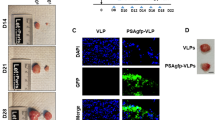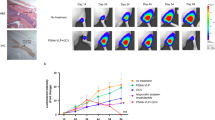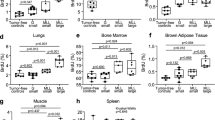Abstract
The sodium-iodide symporter (NIS) directs the uptake and concentration of iodide in thyroid cells. We have extended the use of NIS-mediated radioiodine therapy to prostate cancer. We have developed a prostate tumor specific conditionally replicating adenovirus that expresses hNIS (Ad5PB_RSV-NIS). For radiovirotherapy to be effective in humans, the radioiodine dose administered in the pre-clinical animal model should scale to the range of acceptable doses in humans. We performed 131I dose-response experiments aiming to determine the dose required in mice to achieve efficient radiovirotherapy. Efficacy was determined by measuring tumor growth and survival times. We observed that individual tumors display disparate growth rates that preclude averaging within a treatment modality indicating heterogeneity of growth rate. We further show that a statistic and stochastic approach must be used when comparing the effect of an anti-cancer therapy on a cohort of tumors. Radiovirotherapy improves therapeutic value over virotherapy alone by slowing the rate of tumor growth in a more substantial manner leading to an increase in survival time. We also show that the radioiodine doses needed to achieve this increase scaled well within the current doses used for treatment of thyroid cancer in humans.
This is a preview of subscription content, access via your institution
Access options
Subscribe to this journal
Receive 12 print issues and online access
$259.00 per year
only $21.58 per issue
Buy this article
- Purchase on Springer Link
- Instant access to full article PDF
Prices may be subject to local taxes which are calculated during checkout





Similar content being viewed by others
References
Ruijter E, van de Kaa C, Miller G, Ruiter D, Debruyne F, Schalken J . Molecular genetics and epidemiology of prostate carcinoma. Endocr Rev 1999; 20: 22–45.
Chiocca EA, Broaddus WC, Gillies GT, Visted T, Lamfers ML . Neurosurgical delivery of chemotherapeutics, targeted toxins, genetic and viral therapies in neuro-oncology. J Neurooncol 2004; 69: 101–117.
McCormick F . Cancer gene therapy: fringe or cutting edge? Nat Rev Cancer 2001; 1: 130–141.
Yamamoto M, Curiel DT . Cancer gene therapy. Technol Cancer Res Treat 2005; 4: 315–330.
Carrasco N . Iodide transport in the thyroid gland. Biochim Biophys Acta 1993; 1154: 65–82.
Jhiang SM, Cho JY, Ryu KY, DeYoung BR, Smanik PA, McGaughy VR et al. An immunohistochemical study of Na+/I- symporter in human thyroid tissues and salivary gland tissues. Endocrinology 1998; 139: 4416–4419.
Van Nostrand D, Wartofsky L . Radioiodine in the treatment of thyroid cancer. Endocrinol Metab Clin North Am 2007; 36: 807–822 vii–viii.
Mazzaferri EL . Carcinoma of follicular epithelium: radioiodine and other treatments and outcomes. In: Braverman LE, Utiger RD, (eds) The Thyroid: A Fundamental and Clinical Text 7th edn Philadelphia Lippincott - Raven, 1996: pp 922–945.
Scholz IV, Cengic N, Baker CH, Harrington KJ, Maletz K, Bergert ER et al. Radioiodine therapy of colon cancer following tissue-specific sodium iodide symporter gene transfer. Gene Ther 2005; 12: 272–280.
Dwyer RM, Schatz SM, Bergert ER, Myers RM, Harvey ME, Classic KL et al. A preclinical large animal model of adenovirus-mediated expression of the sodium-iodide symporter for radioiodide imaging and therapy of locally recurrent prostate cancer. Mol Ther 2005; 13: 1185–1191 12 (5): 835–841.
Dwyer RM, Bergert ER, O’Connor MK, Gendler SJ, Morrris JC . Sodium iodide symporter-mediated radioiodide imaging and therapy of ovarian tumor xenografts in mice. Gene Ther 2006; 12: 272–280 13: 60–66.
Spitzweg C, Dietz AB, O’Connor MK, Bergert ER, Tindall DJ, Young CY et al. In vivo sodium iodide symporter gene therapy of prostate cancer. Gene Ther 2001; 8: 1524–1531.
Morris JC http://clinicaltrials.gov/ct/show/NCT00788307 2009.
Herrmann F . Cancer gene therapy: principles, problems, and perspectives. J Mol Med 1995; 73: 157–163.
Waehler R, Russell SJ, Curiel DT . Engineering targeted viral vectors for gene therapy. Nat Rev Genet 2007; 8: 573–587.
Chu RL, Post DE, Khuri FR, Van Meir EG . Use of replicating oncolytic adenoviruses in combination therapy for cancer. Clin Cancer Res 2004; 10: 5299–5312.
Trujillo MA, Oneal MJ, McDonough S, Qin R, Morris JC . A probasin promoter, conditionally replicating adenovirus that expresses the sodium iodide symporter (NIS) for radiovirotherapy of prostate cancer. Gene Therapy 2010; 17 (11): 1325–1332.
Dingli D, Peng KW, Harvey ME, Greipp PR, O’Connor MK, Cattaneo R et al. Image-guided radiovirotherapy for multiple myeloma using a recombinant measles virus expressing the thyroidal sodium iodide symporter. Blood 2004; 103: 1641–1646.
Du Bois EF . Basal Metabolism in Health and Disease. Lea and Febiger Philadelphia, PA, USA, 1936.
Sharma V, McNeill JH . To scale or not to scale: the principles of dose extrapolation. Br J Pharmacol 2009; 157: 907–921.
West LJ, Pierce CM, Thomas WD . Lysergic acid diethylamide: its effects on a male asiatic elephant. Science 1962; 138: 1100–1103.
Anonymous. A compound in red wine makes mice live longer, healthier. Mayo Clin Health Lett 2007; 25: 4.
Baur JA, Pearson KJ, Price NL, Jamieson HA, Lerin C, Kalra A et al. Resveratrol improves health and survival of mice on a high-calorie diet. Nature 2006; 444: 337–342.
Therasse P, Arbuck SG, Eisenhauer EA, Wanders J, Kaplan RS, Rubinstein L et al. New guidelines to evaluate the response to treatment in solid tumors. European Organization for Research and Treatment of Cancer, National Cancer Institute of the United States, National Cancer Institute of Canada. J Natl Cancer Inst 2000; 92: 205–216.
Dingli D, Cascino MD, Josic K, Russell SJ, Bajzer Z . Mathematical modeling of cancer radiovirotherapy. Math Biosci 2006; 199: 55–78.
Reagan-Shaw S, Nihal M, Ahmad N . Dose translation from animal to human studies revisited. Faseb J 2008; 22: 659–661.
Siddiqui F, Barton KN, Stricker HJ, Steyn PF, Larue SM, Karvelis KC et al. Design considerations for incorporating sodium iodide symporter reporter gene imaging into prostate cancer gene therapy trials. Hum Gene Ther 2007; 15: 1022–1033 18 (4): 312–322.
Van Nostrand D, Atkins F, Yeganeh F, Acio E, Bursaw R, Wartofsky L . Dosimetrically determined doses of radioiodine for the treatment of metastatic thyroid carcinoma. Thyroid 2002; 12: 121–134.
USFDA Guidance for Industry: Estimating the Maximum Safe Starting Dose in Adult Healthy Volunteer. US Food and Drug Administration Rockville, MD, 2005.
Gurney H . How to calculate the dose of chemotherapy. Br J Cancer 2002; 86: 1297–1302.
Kozusko F, Bourdeau M, Bajzer Z, Dingli D . A microenvironment based model of antimitotic therapy of Gompertzian tumor growth. Bull Math Biol 2007; 69: 1691–1708.
Bajzer Z, Carr T, Josic K, Russell SJ, Dingli D . Modeling of cancer virotherapy with recombinant measles viruses. J Theor Biol 2008; 252: 109–122.
Rosen JM, Jordan CT . The increasing complexity of the cancer stem cell paradigm. Science 2009; 324: 1670–1673.
Patrawala L, Calhoun T, Schneider-Broussard R, Li H, Bhatia B, Tang S et al. Highly purified CD44+ prostate cancer cells from xenograft human tumors are enriched in tumorigenic and metastatic progenitor cells. Oncogene 2006; 25: 1696–1708.
Hurt EM, Kawasaki BT, Klarmann GJ, Thomas SB, Farrar WL . CD44+ CD24(−) prostate cells are early cancer progenitor/stem cells that provide a model for patients with poor prognosis. Br J Cancer 2008; 98: 756–765.
Rommelfanger DM, Offord CP, Dev J, Bajzer Z, Vile RG, Dingli D . Dynamics of melanoma tumor therapy with vesicular stomatitis virus: explaining the variability in outcomes using mathematical modeling. Gene Ther 2012; 19: 543–549.
Dey-Guha I, Wolfer A, Yeh AC, Albeck JG, Darp R, Leon E et al. Asymmetric cancer cell division regulated by AKT. Proc Natl Acad Sci USA 2011; 90: 3539–3543 108 (31): 12845–12850.
Acknowledgements
We thank Tracy Decklever at the Nuclear Medicine Animal Imaging Resource Mayo Clinic, Rochester for technical help and Dr David Dingli at the Department of Molecular Medicine, Mayo Clinic, Rochester, MN, for helpful discussion. This work was supported by Prostate SPORE Grant P50 CA 091956, Donald J Tindall, PI, John C Morris, Project Director.
Author information
Authors and Affiliations
Corresponding author
Ethics declarations
Competing interests
The authors declare no conflict of interest.
Rights and permissions
About this article
Cite this article
Trujillo, M., Oneal, M., McDonough, S. et al. A steep radioiodine dose response scalable to humans in sodium-iodide symporter (NIS)-mediated radiovirotherapy for prostate cancer. Cancer Gene Ther 19, 839–844 (2012). https://doi.org/10.1038/cgt.2012.68
Received:
Revised:
Accepted:
Published:
Issue Date:
DOI: https://doi.org/10.1038/cgt.2012.68
Keywords
This article is cited by
-
The sodium iodide symporter (NIS) as theranostic gene: potential role in pre-clinical therapy of extra-thyroidal malignancies
Clinical and Translational Imaging (2023)
-
Dual-targeted NIS polyplexes—a theranostic strategy toward tumors with heterogeneous receptor expression
Gene Therapy (2019)
-
NES1/KLK10 and hNIS gene therapy enhanced iodine-131 internal radiation in PC3 proliferation inhibition
Frontiers of Medicine (2019)
-
Potentiating prostate cancer immunotherapy with oncolytic viruses
Nature Reviews Urology (2018)
-
Sequence-defined cMET/HGFR-targeted Polymers as Gene Delivery Vehicles for the Theranostic Sodium Iodide Symporter (NIS) Gene
Molecular Therapy (2016)



